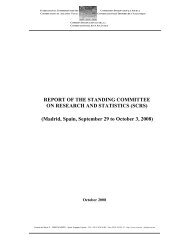REPORT OF THE 2008 ICCAT WORKING GROUP ON STOCK ...
REPORT OF THE 2008 ICCAT WORKING GROUP ON STOCK ...
REPORT OF THE 2008 ICCAT WORKING GROUP ON STOCK ...
You also want an ePaper? Increase the reach of your titles
YUMPU automatically turns print PDFs into web optimized ePapers that Google loves.
WG Stock Assessment Methods – Madrid <strong>2008</strong>dominant species in the catch composition were identified: bigeye tuna, albacore tuna and yellowfin tuna.These three species can be considered as target species.Following the approach, the proportion of each target species catch within the total target catch was calculated(Figure 2). This proportion was applied to decompose the total number of hooks to the number of hooks for eachtarget species (Figure 3).Even considering this method as an approximation to species-specific longline effort, the outcome wouldcontribute to improve the estimation of fishing effort (and capacity) associated with each major species.On the other hand, the total number of hooks by year gives an overall indicator of the total longline fishingcapacity evolution over time. This estimate (total hooks by fleet and year) was made during the 2007 meeting ofthe Sub-Committee on Ecosystems (Anon, 2007). An update of those estimates was presented by the Secretariatand is shown in Figure 4. Estimates for 2006 are provisional, once the two major longline fleets only coverspartial data (Chinese Taipei bigeye fleet and a substitution Japanese by 2006 TASK II C/E).2.2.2 Baitboat effort pattern estimation from Task II catch & effort statistics. General Linear Model used toobtain standardized estimates of effort for the baitboat fishery in the <strong>ICCAT</strong> regionA General Linear Model (GLM) was applied to data from baitboats operating in the <strong>ICCAT</strong> region in order toobtain a standardized estimate of effort trend over the available time period. The dataset was composed ofinformation regarding effort (in various unstandardized forms) expended per flag. Nominal Task I catch datawere added to the dataset to calculate CPUE.MethodologyThe aggregated annual C/E sample data for baitboats were first separated into samples of tropical tunas(yellowfin, bigeye, skipjack) and of temperate tunas (bluefin and albacore) over the period 1950-2005. Theseobservations represented samples obtained from the full suite of flags for which reports have been entered intothe <strong>ICCAT</strong> data set. The model was applied using the statistical package R ver. 2.4.1. (R Development CoreTeam 2003). The input data were the CPUE series obtained by dividing the nominal catch per flag per year, bythe unit of effort provided for that fleet. The factors included in the GLM were flag, effort type (the unit ormeasure of the effort value provided) and calendar year. All factors were categorical in nature. The data wereseparated into two sets. The first set included the temperate tuna species (bluefin and albacore) while the secondincluded the tropical tunas (yellowfin, bigeye and skipjack).The two models constructed using the CPUE data are described in more detail below.a) Data used in the modelsCATCH AND EFFORT DATA - The CPUE series based on yearly catch by flag divided by the total effortexpended per year was used. In the models, the CPUE data was log transformed, and a constant of 1 was addeddue to the prevalence of 0 catch data cells in the catch matrix.YEAR – The calendar year in which harvesting occurred was used.FLAG – The fishing nation responsible for the catchEFFORT TYPE – Effort data for the baitboat fleet in the <strong>ICCAT</strong> region displayed a wide variety in effort units.Anything from days fishing to number of poles has been captured as an index of effort. The different units ofeffort were coded and included in the model as a categorical factorb) Temperate tuna GLMTwo separate GLMs were calculated for the temperate tuna species. The CPUE data and hence the model wasseparated by hemisphere. The southern hemisphere dataset was extremely limited prior to 1979 and so the modelwas only initiated in this year. For the northern hemisphere, the model was initiated in 1952. The temperate tunaGLM applied the following equation:4
















